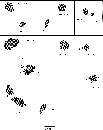The sample consists of 22 isolated pairs with a large variety of
orbital geometries. The selected pairs show tidal tails and
bridges and at least one of the two galaxies is a spiral. We also
required that the spiral structure must be well defined.
Consequently, merger candidates were excluded (our code is
not suitable for studying merging galaxies). The interactions
are close, the projected galaxy separations being less than 2
main galaxy diameters (for NGC 5905/5908 the separation is
about 3-4 galaxy diameters), and their radial velocity
differences are less than ![]() . The sample includes
five primary galaxies and six companions with a bar and one
with a Seyfert 1 nucleus. Figure 1 displays the digitized
Palomar Sky Survey images for the sample pairs converted to
common linear kpc scale. On this plot we can see the mutual
separations of the pair members as well as appreciate the great
variety in the absolute sizes of the sample galaxies.
. The sample includes
five primary galaxies and six companions with a bar and one
with a Seyfert 1 nucleus. Figure 1 displays the digitized
Palomar Sky Survey images for the sample pairs converted to
common linear kpc scale. On this plot we can see the mutual
separations of the pair members as well as appreciate the great
variety in the absolute sizes of the sample galaxies.
The sample can be roughly divided to two subgroups: "M51-type" pairs and "others". In M51-type pairs (see Fig. 1a) the main galaxy has deeply penetrating two-armed spirals (so called Grand-Design arms) and a small companion in its vicinity. These systems are likely candidates for mass exchange. The projected position of the companion often falls at the end of a tidal arm, but not necessarily: we are also interested in other cases since even if there has been material flows along the tidal arms the relative position of the companion may have already changed during the encounter. Similarly, projected superposition does not necessarily imply true material connection. Indeed, reliable assertions concerning the role of mass flows become possible only after constructing models for the likely orbital geometry of each individual pair. As the mass of the companion in M51-type pairs is small, and the companion most probably resides inside the halo of the main galaxy, these systems are good candidates for gravitationally bound systems experiencing several orbital revolutions before the final merger due to dynamical friction. Thirteen of the sample pairs belong to this group, and they will be in the focus of our future investigations.
The remaining 9 pairs (see Fig. 1b) are examples of more distant interactions. In most cases the spiral arms are not as regular as the arms of M51-type galaxies and the companions are more massive. In these systems no mass transfer between the encountering galaxies is expected.


Figure 1: Digital Sky Survey images for the sample pairs. All galaxies
are displayed in the same linear kpc-scale, the distance estimated from the
recession velocity of the primary galaxy with ![]() . a) shows the M51-type pairs (and two marginal
cases: Arp 298 and Kar 331), and b) the other pairs. Arp 218 is not
displayed since there are no redshift measurements
. a) shows the M51-type pairs (and two marginal
cases: Arp 298 and Kar 331), and b) the other pairs. Arp 218 is not
displayed since there are no redshift measurements